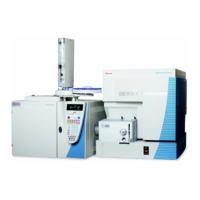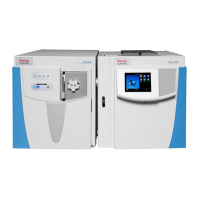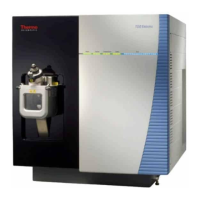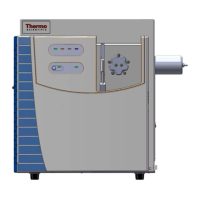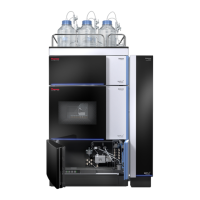1
Introduction
Overview of an LC/MS Analysis
4 TSQ Endura and TSQ Quantiva Hardware Manual Thermo Scientific
and ion optics determines whether positively charged ions or negatively charged ions are
transmitted to the mass analyzer. You can set up data acquisition methods for the mass
spectrometer to analyze positively or negatively charged ions or to switch between these
polarity modes during a single run.
The data system serves as the user interface to the mass spectrometer, autosampler, LC pump,
and syringe pump. Refer to the Xcalibur Help for more information about the TSQ Endura
MS or TSQ Quantiva MS data processing and instrument control application.
Each sequence of loading a mass analyzer with ions followed by mass analysis of the ions is
called a scan. The mass spectrometer uses several different iterations of the selected ion
monitoring (SIM) scan type to load, fragment, and detect ions. The ability to vary not only
the ionization and ion polarity modes, but the scan mode and scan type, provides greater
flexibility in the instrumentation for solving complex analytical problems.
For information about the heated-electrospray (H-ESI), atmospheric pressure chemical
ionization (APCI), and atmospheric pressure photoionization (APPI) techniques, refer to the
Ion Max NG and EASY-Max NG Ion Sources User Guide. For information about the
nanoelectrospray ionization (nanoESI or NSI) technique, refer to the manual that came with
your NSI source.
The mass spectrometer’s triple-stage mass analyzer performs either one stage or two stages of
mass analysis:
Analysis by direct infusion or flow injection provides no chromatographic separation of
components in the sample before they pass into the mass spectrometer. The data system then
processes and stores the data.
• The TSQEndura or TSQQuantiva system operates as a conventional mass spectrometer
with one stage of mass analysis. The ion source ionizes the sample, and mass analysis of
the ion products occurs in the first rod assembly. The second and third rod assemblies
transmit the resulting mass-selected ions to the ion detection system.
1
–or–
• The TSQ Endura or TSQ Quantiva system operates as a tandem mass spectrometer with
two stages of mass analysis. The ion source ionizes the sample, and mass analysis of the
ion products occurs in the first rod assembly. In this case, however, mass-selected ions
exiting the first rod assembly collide with an inert gas in the second rod assembly and
fragment to produce a set of ions known as product ions. (A chamber called the collision
cell surrounds the second rod assembly. The collision cell can be pressurized with an inert
gas.) The product ions undergo further mass analysis in the third rod assembly to detect
selected ions. Two stages of mass analysis yield far greater chemical specificity than a
single stage can achieve because of the system’s ability to select and determine two discrete
but directly related sets of masses.
1
You can also use the instrument as a single-stage mass spectrometer by transmitting the ions through the first and
second rod assemblies followed by mass analysis in the third rod assembly.
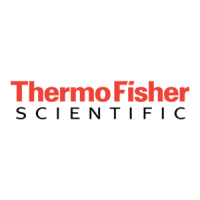
